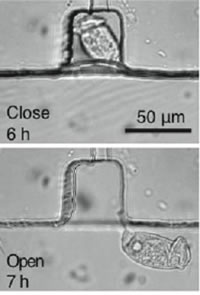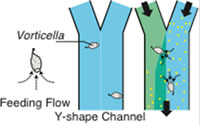Research highlights
Cilia of Vorticella for Active Microfluidic Mixing
Active elements are fundamental components of many microsystems. Traditional elements with nonliving, artificial actuators require an external power source for operation, with magnetic and electric fields necessary to drive the active elements and increase the size of the devices.
The active element size is an obstacle that hinders further miniaturization of microfluidic systems and which therefore prevents compact system fabrication. Sophisticated biological motors from living microorganisms are applicable in microsystems functionalization while reducing the overall size of devices.
Moeto Nagai and colleagues at Toyohashi University of Technology have shown directional fluid transport induced by coordinated ciliary motion in living Vorticella microorganisms for microfluidic applications.
Fluid transport was applied to enhance the mixing of solutions containing microparticles in a microchannel that had been functionalized with Vorticella. Two solutions were injected and a stable laminar continuous flow was generated to measure the mixing performance. Changes in intensity profiles and mixing indexes were measured along the flow direction. A method to pattern Vorticella in micropockets was also developed to extend the possibilities for device design.
Particle transport by several cells of Vorticella enhanced the mixing of the solutions. Decreasing the flow speed enhanced the mixing performance. A three-layer device equipped with a pneumatic valve enables confinement of Vorticella with removal of the suction pressure. Most trapped cells adhered in the pockets for 6 h. The pocket geometry controlled the Vorticella posture.
Application of the coordinated ciliate motion is expected for portable bioanalytical systems capable of analyzing less-diffusive materials.
- Reference:
- Authors: Moeto Nagai, Yo Hayasaka, Kei Kato, Takahiro Kawashima, and Takayuki Shibata.
- Title of original paper: Mixing of solutions by coordinated ciliary motion in Vorticella convallaria and patterning method for microfluidic applications.
- Journal, volume, pages and year: Sensors and Actuators B: Chemical 188, 1255–1262 (2013).
- Digital Object Identifier (DOI): 10.1016/j.snb.2013.08.040
- Affiliation(s): Department of Mechanical Engineering, Toyohashi University of Technology.
- Website:http://mems.me.tut.ac.jp/

Moeto Nagai
Enlarge Image

Figure1: Micrograph of Vorticella in microchannel.
Enlarge Image

Figure 2: Schematic of micromixing by Vorticella.
Enlarge Image


